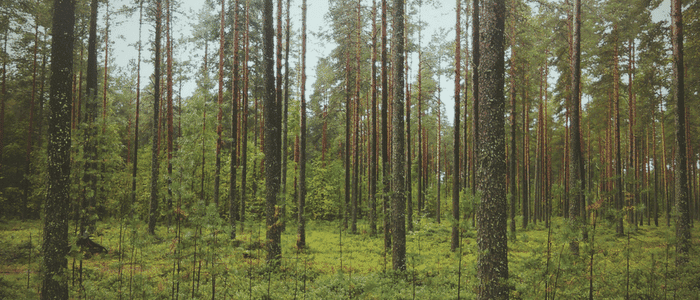Trees As A Cash Crop:
The Crating Industry & The Environment
How can an industry based on making products from trees become environmentally friendly? Well, you might be surprised by the answer.
Have you ever been to a southern yellow pine farm?
If you’ve driven through the South then chances are you have. Most of them look exactly like forests.
Much of the south’s lumber comes from private land where trees are growing and being harvested in sustainable ways. And most sustainable tree farming practices mean not clear-cuts, but cutting down mature trees here and there, leaving the forest intact. The majority of the southern yellow pine timber lands look exactly like forests—because they are.
We start with this story because many people erroneously assume that the lumber used for making pallets and crates means that large swaths of land get clear cut, leaving ugly blemishes on the forest that will never grow back. But in reality, you would hardly notice a tree farm. And in North America, tree farming is a sustainable practice. According to the US Forest Service, the country’s forests are growing. Each year we add about 3% to our forests and cut down about 2%, meaning that the current levels of tree farming are sustainable and the forest renewable.
So just like bakers use wheat and confectioners use sugar, craters use wood as a renewable cash crop that they then add value to. But unlike wheat and sugar, our raw materials have extra responsibilities as well as extra opportunities associated with them in the form of reuse and recycling.
Using Wood And Pulp in the Greenest Ways
Despite the fact that wood can be used and harvested in sustainable ways, the special environmental benefits of forests should not be overlooked. Wasting wood products is bad for the environment and also bad for the bottom line. There are many issues at play here in reducing the environmental impact of the crating industry. Here at Reid Packaging, we’re constantly looking for ways to lessen our environmental impact by reducing our consumption and streamlining our operation. Here are some ways that we reduce our environmental impact:
-
Reducing Use
-
Reusing & Repairing
-
Reducing Weight
-
Local Sourcing
-
Recycling Cardboard
The less wood we have to use to make a crate and the less we waste, the better. This means: measuring twice and cutting once. This means: using wood drops and offcuts when possible. This means: using the correct type of wood thickness and strength for the job. This means: refurbishing old crates and pallets when possible.
A well-built pallet will last 100 trips. But even after 100 trips, a pallet can be repaired and rebuilt using less material than constructing a new one.
While Reid Packaging does not deal in remanufactured pallets it is not uncommon for us to take in damaged tradeshow crates for refurbishing, often crates we didn’t build in the first place. This service saves the customer the cost of a new crate and the disposal of the damaged one.
A well-built crate that uses Klimp® fasteners can be opened, modified, and rebuilt without damaging the wood. These fasteners help to reduce wood waste by 87% according to the manufacturer’s website.
Taking a few pounds off of the weight of a crate by using the correct plywood and reducing unneeded materials might not sound like a big deal. But if you are building and transporting 1,000 of these crates, then the added weight turns into higher fuel consumption and higher freight costs. It’s the same with the size of our crates. Cutting a few inches off of a crate that is being reproduced 100 times might save an entire truckload, or more.
By paying close attention to the weight and size of our constructions we help our clients save money and help the environment in the meantime.
The southern states are called the “woodbasket” of the US for a reason. The South comprises about 24% of the country’s land, but is responsible for 40% of the country’s timberland (according to the USDA Forest Service [pdf]). These 210 million acres of timber land are where much of the country’s supply of wood and wood pulp comes from. This means that we don’t have to go far to get our wood. The majority of it comes from within 150 miles!
Cardboard is abundant around our shop. But we are very happy to report that our cardboard is made from 79% recycled material, and that the national recycling of cardboard continues to increase dramatically. In 2013, the EPA reported that about 89% of cardboard was recovered.
These are just some of the ways that we’re committed to putting the environment first as we design and build the best crates and packaging systems for our clients.
Get in touch to learn more about our crates!

